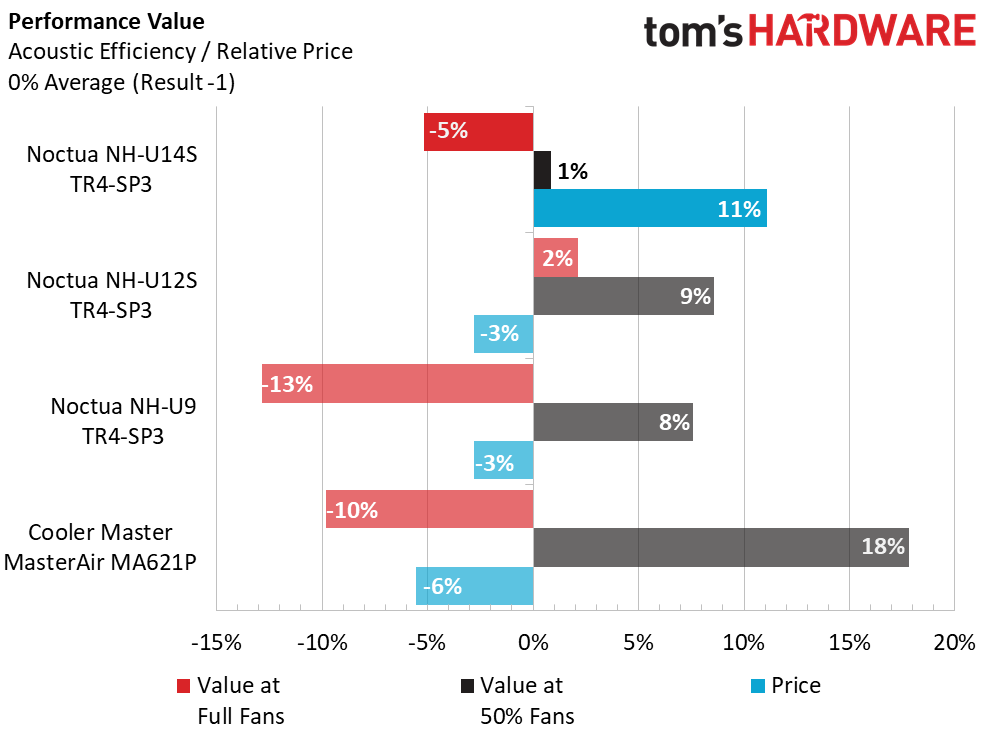Noctua NH-U14S TR4-SP3 Review: Silent Threadripper Overclocking
Why you can trust Tom's Hardware
Testing Results & Conclusion
Comparison Products
Using information collected from previous Threadripper cooling tests, we compared the NH-U14S TR4-SP3 to two of its siblings, the NH-U12S TR4-SP3 and the NH-U9 TR4-SP3, as well as the Cooler Master MasterAir MA621P. Our AMD Threadripper 1900X eight-core CPU was clocked to 4.1GHz at 1.40v on our MSI X399 Gaming Pro Carbon AC motherboard, housed within a Corsair Carbide 760T chassis.
While we saw a somewhat close set of thermal load results, there are a few interesting things to dig through as we further compare our testing quartet. With the lowest load temperatures at full and half speed fan settings, the NH-U14S TR4-SP3 is off to a good start.
Utilizing that 140mm NF-A15 fan, the Noctua NH-U14S TR4-SP3 spun the slowest, with its 120mm NH-U12S TR4-SP3 sibling rotating close behind. The NH-U9 TR4-SP3 runs dual 92mm fans, which explains the higher redline. The MasterAir MA621P uses a pair of 120mm fans nestled within its large, dual heatsink tower configuration.
After comparing fan speeds, our decibel level graph shows the buzzy, twin 92mm fans on the NH-U9 TR4-SP3 ran almost exactly at the same registered noise levels as the dual 120mm MasterAir MA621P. The NH-U14S TR4-SP3 and NH-U12S TR4-SP3 models netted nearly identical results here.
With the overall best thermal performance and the lowest noise levels, it’s no surprise that the NH-U14S TR4-SP3 performed favorably in our acoustic efficiency comparison. Offering great cooling with low noise levels provided a marked advantage.
Priced at $80, the NH-U14S TR4-SP3 carries the highest cost premium of our group by at least $10, making it an obvious qualifier for premium-tier performance air cooling. By producing the lowest thermal load temperatures at the lowest sound levels, the NH-U14S TR4-SP3 proved that it, indeed, belongs in this premium category for cooling Threadripper CPUs.


Thermal imaging from the FLIR One PRO showed minimal difference between the NH-U14S TR4-SP3 at half versus full speed. At 100% fan revolutions per minute (RPM), the ejected air mass around the cooling tower was a bit more noticeable, and at 50%, we saw indication of slight thermal hot spots at the heatpipe tips and in localized areas on the top of the cooling fin stack. However, minimal differences between these images shows how well the NH-U14S TR4-SP3 focuses airflow through the cooling tower regardless of functional fan rotation speeds.
Get Tom's Hardware's best news and in-depth reviews, straight to your inbox.
Conclusion
We realize that questions might be surfacing around the cost and performance of the Noctua NH-U14S TR4-SP3 and the NH-U12S TR4-SP3 and even the Cooler Master MasterAir MA621P, and rightfully so. The slower fan on the NH-U14S is larger than that found on the NH-U12S (120mm) and the dual 120mm RBG fans adorning the MasterAir MA621P.
Simply put, the thicker, dual-tower / dual-fan MA621P focuses on price and appearance while the Noctua products focus on reduced temperatures and noise. If you're looking to cool on a budget and want something that looks nice, Cooler Master's product may be a better fit. But if you're priority is more around cooling your overclocked Threadripper and doing so quietly, the Noctua NH-U14S TR4-SP3 is a great buy.
MORE: Best CPU Cooling
MORE: How To Choose A CPU Cooler
MORE: All Cooling Content

Garrett Carver is a contributor for Tom’s Hardware, primarily covering thermal compound comparisons and CPU cooling reviews; both air and liquid, including multiple variations of each.
-
jpe1701 How big of a difference is it to cool one of the higher core count Threadripper chips? It would be interesting to see one of the coolers already tested with the 1900x on the 1950x just to see the difference.Reply -
tamalero My only gripe of the threadripper design and these kind of coolers is, they throw ALL the hot air into the second memory channel group. And this can cause instability on high clocked rams.Reply -
rantoc Noctua's typical strategy seems to prevail - premium quality/performance but at a premium price. As long as a majority of that premium price goes into a better product i'm all game for that.Reply -
rubix_1011 Reply21232443 said:How big of a difference is it to cool one of the higher core count Threadripper chips? It would be interesting to see one of the coolers already tested with the 1900x on the 1950x just to see the difference.
We're looking to source a high-core TR-2 CPU for ongoing Threadripper testing. When we originally started our TR4 testing, it was difficult to also source Threadripper chips for a time, so we went with the 1900X. -
paul prochnow Does that thermal imaging suggest you cook two RAM stickS ? ? ?Reply
at $80 liquid cool is not far higher and would get the THERMALs
outta der case, Rudy ! ! ! -
rubix_1011 PC hardware is designed for much higher temperatures than we are, so 'cooking' something would require temps usually in excess of 100C (212F, the boiling point of water).Reply
Also, the airflow over the motherboard components is likely more beneficial to the memory DIMMs than the lack of it with a liquid cooling solution.
Another also - DDR4 runs much cooler overall than DDR3 and certainly cooler than DDR2.







